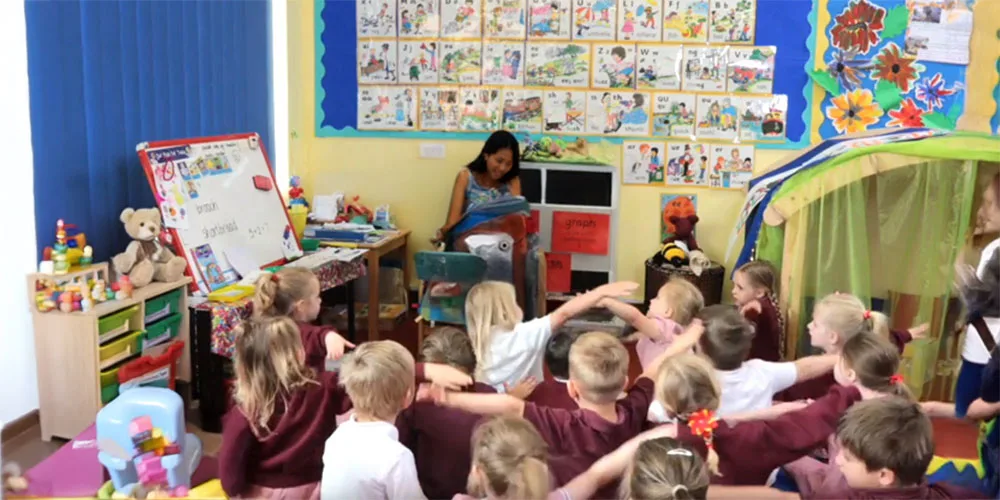The Jolly Phonics Program
JOLLY PHONICS – A PROGRAM THAT GROWS WITH YOUR CHILDREN

International preschool children engaging in the Jolly Phonics program, learning to read and write with British phonics visuals in a colourful early literacy classroom, guided by a teacher as part of a British curriculum for ages 6 months to 6 years.
Jolly Phonics Program at Our International Preschool
(6 Months to 6 Years)
At Umalas Kids Club, we proudly incorporate this British phonics approach as a key component of our early literacy journey. Used in classrooms worldwide, it helps children from 6 months to 6 years build a strong reading and writing foundations.
As an international preschool in Bali, we integrate Jolly Phonics into our British Curriculum to support fun, effective, and age-appropriate learning and development.
What Is Jolly Phonics and Why Is It Effective?
Jolly Phonics is a play-based phonics program that introduces children to synthetic phonics—a method proven to accelerate early literacy. Children learn 42 letter sounds using fun hand motions, songs, and engaging visuals.
This multi-sensory approach keeps young learners motivated while developing phonological awareness, sound blending, and word recognition.
???? Want to understand more about our curriculum? Check out our British Curriculum overview.
Jolly Phonics aligns with how children naturally explore the world: through play, repetition, and curiosity. At UKC, we support each child’s pace through daily literacy games, small group sessions, and hands-on activities.
The 5 Core Skills Taught in Our Phonics Learning Program
1 – Learning the Letter Sounds
One of the most exciting stages in early literacy is when children begin to identify the sounds that make up language. In this phonics method, learners are introduced to 42 distinct letter sounds—these include single-letter sounds like “s” and “t”, as well as common digraphs such as “sh”, “ch”, and “ai”.
Each sound is taught through playful songs, hand movements, and stories that help the child associate meaning and motion with the sound. These multi-sensory techniques not only make learning more engaging but also support memory retention and pronunciation development.
For international learners, this step is especially valuable as it builds a solid foundation in spoken English, critical for confident communication.
2 – Letter Formation with Movement
Once children start to recognize sounds, they begin learning how to write each letter. This isn’t done through rote repetition but rather through activities designed to build fine motor skills.
Children might trace letters in sand, form them with playdough, or use finger painting to create shapes before ever picking up a pencil. This tactile, engaging process helps connect sound, shape, and motion—boosting hand-eye coordination and early handwriting fluency.
Letter formation is not just a writing activity—it enhances visual recognition and strengthens a child’s understanding of how spoken and written language connect.
3 – Blending Sounds into Words
Blending is the step where everything starts to click. Children learn to combine individual letter sounds into whole words. For instance, they might blend “s-a-t” to read “sat” or “b-r-i-ng” to sound out “bring”.
This is one of the most rewarding skills for children to master, as it marks the beginning of independent reading.
In our preschool environment, blending is taught using games, puzzles, and read-alouds where kids can hear and see how sounds merge into real, meaningful language.
4 – Segmenting Words for Spelling
Just as blending helps with reading, segmenting builds the skills needed for spelling and writing. Here, children are encouraged to take words apart by identifying the individual sounds.
For example, the word “dog” is broken down into “d-o-g”. This process strengthens phonemic awareness and gives children the tools to sound out and spell new words on their own.
It also allows them to recognize spelling patterns and make connections between words that share similar sounds or endings, like “jump”, “bump”, and “stump”.
5 – Tricky Words Made Simple
English includes many words that don’t follow standard phonetic rules—these are known as tricky words. Words like “the”, “was”, or “said” can’t easily be decoded by sound alone.
Rather than letting these exceptions cause frustration, we introduce them as “memory words” using visuals, songs, and repetition to help children recognize them by sight.
This gentle approach builds reading fluency and confidence, allowing learners to progress without getting stuck on irregular spellings.
By mastering tricky words early, children can read real sentences more smoothly and enjoy the experience of independent reading.
How Our British Curriculum Strengthens Early Literacy
This structured early reading method is enhanced with Jolly Grammar and Jolly Readers—offering a complete path from recognition to confident literacy. It fits perfectly into our play-based learning philosophy, which supports creativity, problem-solving, and emotional growth.
We customize instruction based on your child’s stage—whether they’re learning their first sounds or beginning to write short sentences.
???? Explore our full Play-Based Curriculum or see the various and flexible ways to join us!
Learn More or Get in Touch
Ready to see your child thrive in a supportive and engaging preschool?
???? Contact us for a tour or learn about enrolment.
Or visit the official Jolly Phonics website for in-depth program details.
